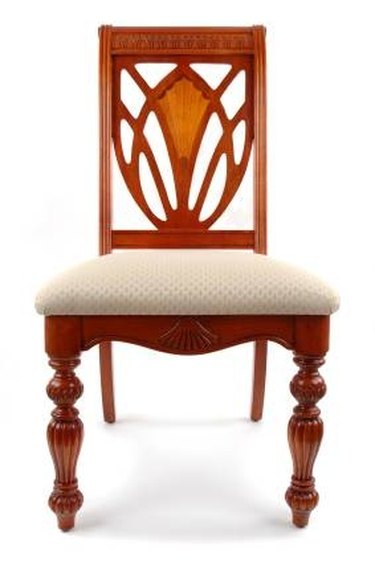Things You'll Need
Power screwdriver
Kraft paper
Pencil
Scissors
Jigsaw
3/8-inch plywood (a three-foot section will do)
Spray-mount glue
1- to 2-inch sheet foam (1 yard will do)
Electric knife (like you use to carve a turkey)
Fabric of choice
Staple gun (heavy-duty)
Staples
Small hammer
Wood screws

Many of the most popular styles of kitchen and dining room chairs have upholstered seats that are affixed to the chair frame by small screws through the bottom of the seat and frame. Because of time and sometimes rough handling, the seat may split or become broken. Sometimes the mounting areas of the wood will fail due to loose screws moving back and forth when the chair is sat on frequently. Replacing these chair seats is not difficult.
Step 1
Remove the existing seat and trace the outline of the seat onto the Kraft paper. If the seat is missing, then simply place the Kraft paper on the chair where the seat should fit and mark the shape onto the paper.
Video of the Day
Step 2
Cut the shape of the seat out of the paper and test fit it on the chair. Trim the template as necessary. Do the fitting with the paper, since it is more difficult to trim the plywood. When the paper fits the seat well, trim the pattern by 1/8th inch all around. This allows for fabric. Then place the paper template onto the plywood.
Step 3
Trace the template onto the plywood with a pencil. Using a jigsaw, cut along the pencil mark.
Step 4
Fit the new seat to the chair. It should fit comfortably.
Step 5
Place the wood seat on a fresh piece of Kraft paper in a well-ventilated area. Shake the spray glue well and spray the wood.
Step 6
Apply the foam to the glue and press firmly. Allow the glue to dry (based on the manufacturer's recommendation).
Step 7
Turn the seat and foam over and use the electric knife to cut the foam to the shape of the wood. Place the seat on the edge of a table with the foam on the bottom. Use the wood of the seat as a guide and turn the seat while cutting.
Step 8
Lay the fabric upside down and center the seat on the fabric. The seat should be foam side down.
Step 9
Wrap the fabric over the front side, all the way around the foam to the plywood (now the seat bottom). Staple away from the plywood edge at least two inches, starting in the center. Wrap the fabric over the back side the same way, pull it snug, and staple it in the center.
Step 10
Work toward the corners, balancing the staples from front to back so that the fabric is pulled snug evenly. Then do the same thing on the sides, easing the corners last. Easing means to add small amounts of excess fabric between each staple so that the fabric doesn't bunch up at the corners. Trim away excess fabric. Tap down any protruding staples with the hammer.
Step 11
Install the seat by inverting the chair and screwing the screws into the plywood through the mounting holes in the chair.
Tip
Consider drilling pilot holes for the screws to help the screws draw the seat down firmly. Don't bunch the fabric in the corners when you are stapling; ease the fabric and trim wedges at the corners to reduce the amount of fabric.
Warning
Older chairs may have flattened over time; the two-inch foam may be too tall, and the one-inch foam too short. Use the one-inch and add quilter's padding to achieve the correct height.
Video of the Day